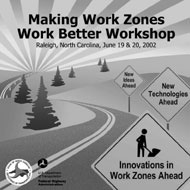U.S. Department of Transportation
Federal Highway Administration
1200 New Jersey Avenue, SE
Washington, DC 20590
202-366-4000
Focus
| Accelerating Infrastructure Innovations |
Publication Number: FHWA-RD-02-013
Date: August 2002
The North Carolina Department of Transportation (DOT) and the Federal Highway Administration (FHWA) teamed up recently with the goal of "Making Work Zones Work Better." At a pilot work zone mobility and safety workshop held in Raleigh, North Carolina, in June 2002, 115 participants heard presentations on such topics as worker safety, work zone strategies, traffic management, contracting, and travel information. The event served as the pilot for a series of work zone workshops that will be held around the country over the next 18 months.

"The first one out of the gate is always the most difficult, but we thought it went really well," says Jimmy Travis of North Carolina DOT and a member of the Federal/State team guiding the workshop series. "We had a good cross-section of participants-About 75 percent from North Carolina DOT, 15 percent from utilities and construction, and the rest coming from the North Carolina State Highway Patrol and Department of Motor Vehicles. Everyone was really receptive and open to the new ideas."
The workshop series is part of a nationwide effort on the part of FHWA to promote new technologies, practices, and products that will enhance mobility and safety in highway work zones. In addition to providing lectures by experts in the field, the workshops will feature open forums and other activities where State highway officials can share ideas that have worked for them. State police representatives are also encouraged to participate, as law enforcement is key to making work zones operate effectively.
"Making Work Zones Work Better" is not just a slogan, but a vital necessity. One-thousand and twenty-six persons were killed in work zones in the United States in 2000, with drivers and passengers accounting for roughly 84 percent of that total. "Traffic is growing, congestion is growing, and there are more work zones set up during the repair of our aging highways. More work zones plus more congestion equals more delay and more driver frustration. We need to maximize availability and minimize user impacts. It's more important than ever that our approach to work zones be studied and improved upon," says FHWA's Marianna Rizzo. "There's a common misconception that it's the workers who are most often injured or killed in work zones, but the National Highway Traffic Safety Administration's Fatality Analysis Reporting System statistics show it's really the driving public."
Mobility and safety are not the only important work zone issues covered in the workshop: Lower user costs, better planning and management of corridors, and better traffic management are among the benefits States can receive through improving work zones.
The North Carolina workshop featured such topics as "Making Work Zones More Enforcement Friendly" and "Innovative Traffic Control Devices for Improving Safety at Rural Work Zones." A presentation on the "Dynamic Late Merge Concept" described how this new concept integrates conventional lane closure merge control with the late merge approach, which is designed to encourage drivers to remain in their lanes until the merge point at the lane closure taper. This integration is based on real-time measurements of traffic conditions in advance of the lane closure. Also featured was a case study of the $26 million rehabilitation of the McClugage Bridge in Illinois, which relied on a combination of moveable barrier and interactive traffic management systems to reduce traffic delays. The barrier was moved twice daily to provide two lanes of travel in the direction of peak hour traffic flow. Meanwhile, the portable traffic management system supplied motorists with real-time delay information and suggested alternate routes when backups occurred.
Presenters also assessed new technologies and contracting techniques, including the Wizard CB Alert System, which uses a CB radio transmitter to alert CB users that they are approaching a work zone with a lane closure; intrusion devices that alert workers that a vehicle has penetrated the work zone; and outcome-based contracting procedures, including A+B contracting, lane rental, warranties, and design/build.
After each session, participants had the opportunity to provide feedback, reveal the barriers and challenges they've experienced in implementing certain work zone methods, and talk about other approaches that have been effective for them in the past. "We've found that workshop participants prefer shorter presentations and more discussion time, since that's when they really exchange the most valuable information," says Travis. North Carolina DOT plans to use its experience in coordinating the workshop to help guide other States who will host future workshops.
Following the successful pilot in North Carolina, the workshop series will officially kick off with a September 26, 2002, event in College Park, Maryland, hosted by the Maryland State Highway Administration.
For registration details on the next workshop or for more information on the "Making Work Zones Work Better" program, to find out about hosting a workshop in your State, or to obtain a CD-ROM copy of the FHWA work zone research compendium (see May 2002 Focus), contact Marianna Rizzo at FHWA, 202-366-9631 (email: marianna.rizzo@fhwa.dot.gov). For more information on the North Carolina workshop, contact Jimmy Travis at North Carolina DOT, 919-733-2210 (email: jtravis@dot.state.nc.us).